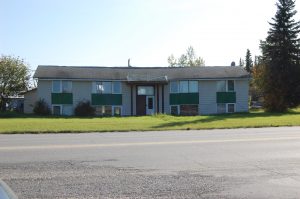Minimizing permafrost thaw beneath the house is critical for any structure built on permafrost. There are some preventative strategies that can be utilized to maintain permafrost integrity for existing buildings.
- Maintain vegetative ground cover. Vegetation acts as an insulating layer from solar radiation. Preventing the disturbance of vegetative ground cover during the construction process is critical to permafrost integrity.
- Clear snow from the house perimeter. Prevent snow drifts from accumulating beneath the house if there is an open foundation. Snow acts as an insulating layer for the ground if the air temperature is lower than freezing.
The melting of permafrost underneath infrastructure can result in costly repairs and extensive damage. The damage can occur slowly (e.g.: heat transfer through a foundation causes further thaw annually) or quickly (e.g.: ruptured water/septic line causes rapid melt in one event).
Repairing a Permafrost Foundation
The Permafrost Technology Foundation (PTF) was formed to develop solutions to permafrost problems. The design manuals and videos created by PTF explain what permafrost is and where it occurs, the importance and procedure for a thorough permafrost site investigation, methods for permafrost stabilization, and some techniques used for building new structures and stabilizing existing structures on permafrost.
PTF performed several case studies on houses that had been suffering from the effects of thawing permafrost. The ones presented here dealt specifically with permafrost there are more case studies available at http://www.cchrc.org/permafrost-technology-foundation-library
![]() Permafrost Technology Foundation: 1183 Grenac Road Foundation Stability Research
Permafrost Technology Foundation: 1183 Grenac Road Foundation Stability Research
A house with a heated crawlspace had significant differential settlement that was remediated by opening up the crawlspace and placing the house on a crib foundation. While requiring periodic re-leveling, the new foundation strategy appeared to have stabilized the permafrost.
![]() Permafrost Technology Foundation: 1.5 Mile Ballaine Road Foundation Stability Research
Permafrost Technology Foundation: 1.5 Mile Ballaine Road Foundation Stability Research
A two-story residence with a crawlspace located on permafrost, including several feet of clear ice, was remediated by ventilating the crawlspace and insulating the utilities. Settling continued through the monitoring period, but was substantially reduced by the remediation strategy.
![]() Permafrost Technology Foundation: 728 Constitution Road Foundation Stability Research
Permafrost Technology Foundation: 728 Constitution Road Foundation Stability Research
A heat pump was retrofitted for a house with a daylight basement to cool the ground underlying the building. The strategy was highly successful, but required proper maintenance of the heat pump to avoid further settlement or too much heat removal leading to frost jacking.
![]() Permafrost Technology Foundation: 1417 Jones Road Foundation Stability Research
Permafrost Technology Foundation: 1417 Jones Road Foundation Stability Research
A house with a shallow pile foundation with settlement problems was replaced with a Triodetic foundation. Differential settlement continued after installing the new foundation, but was shown to be maintainable by periodic leveling maintenance.
![]() Permafrost Technology Foundation: 263 Madcap Lane Foundation Stability Research
Permafrost Technology Foundation: 263 Madcap Lane Foundation Stability Research
A house with a daylight basement on thaw-unstable permafrost had several thermosyphons installed under the entire house footprint. This was successful in slowing the rate of settlement.
![]() Permafrost Technology Foundation: 1732 Rise Road Foundation Stability Research
Permafrost Technology Foundation: 1732 Rise Road Foundation Stability Research
A small house with a crawlspace had substantial differential settlement that was alleviated by placing the house on adjustable jacks. During the monitoring period, the permafrost thawing appeared to stabilize after separating the house from the ground.